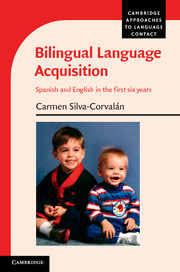Book contents
- Frontmatter
- Dedication
- Contents
- List of figures
- List of tables
- Series editor’s foreword
- Preface
- Acknowledgments
- List of abbreviations
- 1 Introduction
- 2 Methodology
- 3 Bilingual development
- 4 Subjects in English and Spanish
- 5 The order of constituents: subject position in English and Spanish
- 6 The acquisition of ser, estar, and be
- 7 The development of verb morphology
- 8 Discussion and conclusions
- Appendix 1 Transcription instructions
- Appendix 2 Calculation of MLUw
- Appendix 3 Spanish adjectives used with copulas up to age 6;0
- Appendix 4 The siblings’ early verb lexicon in English and Spanish
- Appendix 5 Excerpt from an adapted Goldilocks story
- References
- Index of authors
- General index
1 - Introduction
Published online by Cambridge University Press: 18 December 2014
- Frontmatter
- Dedication
- Contents
- List of figures
- List of tables
- Series editor’s foreword
- Preface
- Acknowledgments
- List of abbreviations
- 1 Introduction
- 2 Methodology
- 3 Bilingual development
- 4 Subjects in English and Spanish
- 5 The order of constituents: subject position in English and Spanish
- 6 The acquisition of ser, estar, and be
- 7 The development of verb morphology
- 8 Discussion and conclusions
- Appendix 1 Transcription instructions
- Appendix 2 Calculation of MLUw
- Appendix 3 Spanish adjectives used with copulas up to age 6;0
- Appendix 4 The siblings’ early verb lexicon in English and Spanish
- Appendix 5 Excerpt from an adapted Goldilocks story
- References
- Index of authors
- General index
Summary
Bilingual language acquisition
The terms bilingual and bilingualism have received diverse definitions. In this book, bilingual (the person), and bilingualism (the condition or state of affairs) refer to the use of two (or more) languages in everyday life. Two major patterns of language acquisition have been identified in studies of early bilingualism: simultaneous bilingualism and sequential bilingualism, but no agreement exists with respect to the age at which bilingual development would be considered to be sequential. In simultaneous bilingualism, the child acquires two languages at the same time from birth or, as some researchers propose, before 3 years of age. Here, I use the term Bilingual First Language Acquisition (BFLA, or 2L1) to refer to situations where the child’s exposure to two languages begins at birth (cf. De Houwer 2009: Ch. 1). This means that the question of the effect that different ages of first exposure to a language may have on the development of bilingual competence is not relevant in BFLA, but it is in sequential bilingualism. The latter could be differentiated, depending on when acquisition of a second language begins, into: (a) successive bilingualism, when the child’s exposure to a second language starts sometime between the first and third birthdays; and (b) early second language acquisition, a form of early bilingualism that happens when a child has one established language before starting to hear and learn a second language (De Houwer 2009: 4). This book focuses on BFLA – that is, on the acquisition of two languages from birth, Spanish and English in this case. The overall goal is to examine whether bilingualism affects the course of development in each language, and if so, how.
It has been estimated that half of the world’s population, if not more, is bilingual (Grosjean 2010: 13; Tucker 1998). In the Spanish-speaking world bilingualism is indeed present, in all social classes and in all age groups, in every country where this language is official or co-official.
- Type
- Chapter
- Information
- Bilingual Language AcquisitionSpanish and English in the First Six Years, pp. 1 - 26Publisher: Cambridge University PressPrint publication year: 2014

